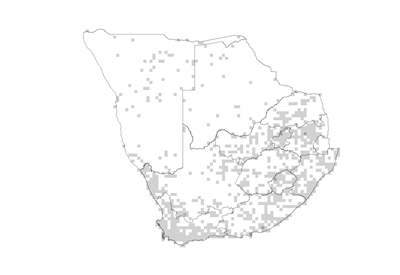 Species distribution and density. Darker squares represent higher density of members of this family. |
Introduction
(including Illecebraceae)Carnation family
A large family famed for carnations, pinks and baby's breath. Despite its size, plants are relatively uniform and easy to recognise.
Distribution
Found worldwide, with highest diversity in temperate regions around the Mediterranean and adjacent parts of Europe and Asia. In southern Africa it is widespread, except inthe more arid areas of the interior.
Number of genera in the world
ca. 80
Number of species in the world
ca. 2 200
Number of genera in the Flora of southern Africa region
22
Number of species in the Flora of southern Africa region
87
Well-known southern African genera
Dianthus, Silene
Growth forms
Mostly perennial herbs or shrublets, rarely shrubs.
Habitats
Found in high altitude tropical mountains (absent from tropical lowland rain forest) to arid areas. Most species prefer dry, open habitats.
Flagship species
Silene burchellii (gunpowder plant; kruitbossie [A]; kopane [SS]; injuju [Z]) commemorates the English botanist, William Burchell [1781-1863]. It is a widespread herb with white to pink flowers that open in the late afternoon and are presumably pollinated by moths. Plants flower throughout the year, but especially during spring. It is used medicinally as a tonic, to combat drowsiness, to treat scrofula or as a love charm.
Significance of the family
Numerous cultivars of carnation (*Dianthus caryophyllus) are grown worldwide, especially for the cut flower market. Other cultivated members of the family include species of Silene, *Gypsophila and *Saponaria. Some species (e.g. *Stellaria media) are annual weeds of disturbed places. Certain species are used in traditional medicine to treat chest ailments, rheumatism and fever, or as good luck charms. The sweet fruit of waxberry (Pollichia campestris) are eaten by people and birds; this species is also browsed by game and stock. (Photo: HV).
Diagnostic characters
Leaves opposite and decussate, very rarely alternate, the bases joined at the swollen nodes , usually without stipules. Flowers regular with 4 or 5 free petals, with tips notched or fringed . Styles (2-5) are separate and slender �. Ovary superior �. Fruit usually a capsule that opens by means of teeth at the apex .
Did you know?
The cushion-forming Antarctic pearlwort (*Colobanthus quitensis) is one of only two flowering plants found in Antarctica.